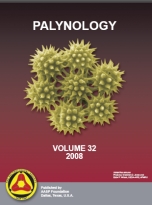Palynology is the main method of correlating the subsurface glaciogenic Al Khlata Formation (Pennsylvanian to Lower Permian) of Oman due to the extreme lateral variability of facies and poor seismic resolution. The chief operating company in Oman, Petroleum Development Oman (PDO), has developed a robust in-house palynozonation during almost 40 years of exploration and production based on thousands of samples and hundreds of well sections. In this paper, the formal definitions of the biozones are published and the biozones are correlated in detail with faunally-calibrated palynomorph biozones in Western Australia. This allows correlation to the standard Russian stages. Seven biozones are distinguished. The oldest two subdivisions, biozones 2159A and 2159B, of probable Late Pennsylvanian age, are characterized by low diversity assemblages of Punctatisporites and monosaccate pollen. Biozone 2159A has a lower proportion of monosaccate pollen than Biozone 2159B. Biozone 2165A, of probable Asselian age, is characterized by common cingulicamerate spores and the Microbaculispora Group. Biozone 2165B contains common Horriditriletes Group, and is likely to be Asselian–Sakmarian in age. The Biozone 2141A is characterized by common taeniate and non-taeniate bisaccate pollen and Cycadopites cymbatus, particularly toward the top. The succeeding Biozone 2141B is recognized by common Microbaculispora Group and Cycadopites cymbatus. Biozones 2141A to 2141C are believed to be Sakmarian in age. The youngest unit, Biozone 2141C, is characterized by the Microbaculispora and Horriditriletes groups, with the former being more abundant. This seven-fold subdivision is a significant improvement on previous palynozonations of the Al Khlata Formation, which only allowed three- or four-fold subdivisions. However, there still remain considerable uncertainties in dating the lowermost biozones, 2159A and 2159B. Improvements in the dating of the Al Khlata Formation are most likely to come from palynological correlations with radiometrically- or faunally-dated successions in South America, eastern Australia, and southern Africa.
How to translate text using browser tools
1 December 2008
A High Resolution Palynozonation for the Al Khlata Formation (Pennsylvanian to Lower Permian), South Oman
Randall A. Penney,
Issam Al Barram,
Michael H. Stephenson
ACCESS THE FULL ARTICLE
It is not available for individual sale.
This article is only available to subscribers.
It is not available for individual sale.
It is not available for individual sale.

Palynology
Vol. 32 • No. 1
December 2008
Vol. 32 • No. 1
December 2008
Al Khlata Formation
biostratigraphy
correlation
Gondwana
Lower Permian
Oman
Pennsylvanian




